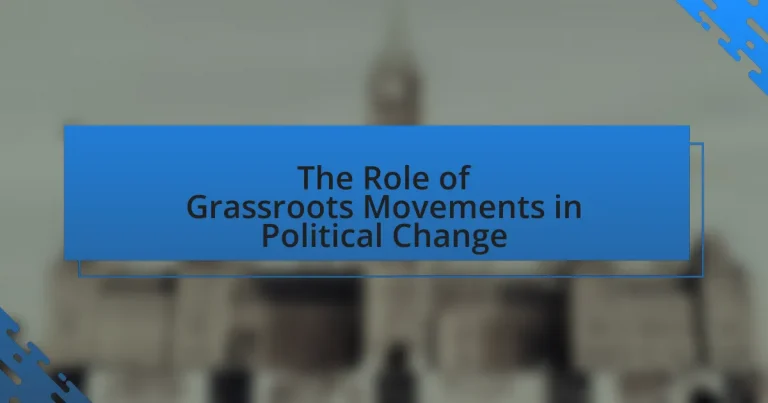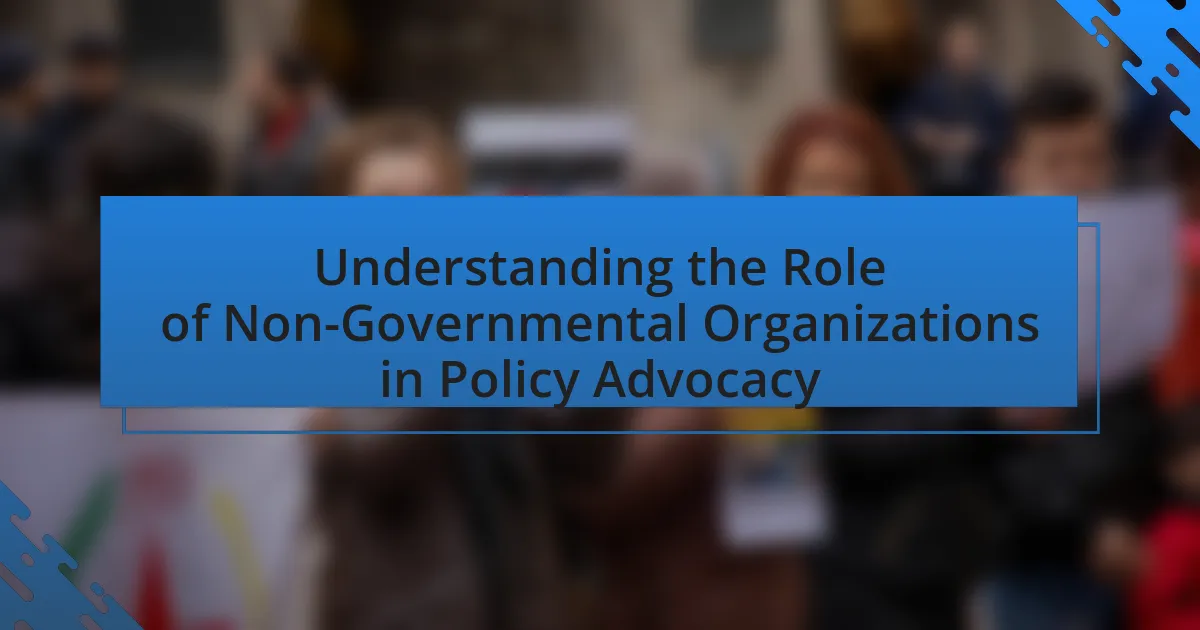Grassroots movements are organized efforts by ordinary citizens at the community level aimed at achieving social or political change. This article explores the significance of grassroots movements in driving political change, highlighting their decentralized structure, community engagement, and strategies for mobilization. It examines historical examples, such as the Civil Rights Movement and the Arab Spring, to illustrate how grassroots activism can challenge established political systems and effect substantial legislative reforms. Additionally, the article discusses the challenges these movements face, including resource limitations and political opposition, while offering insights into effective strategies for overcoming these obstacles and enhancing their impact.
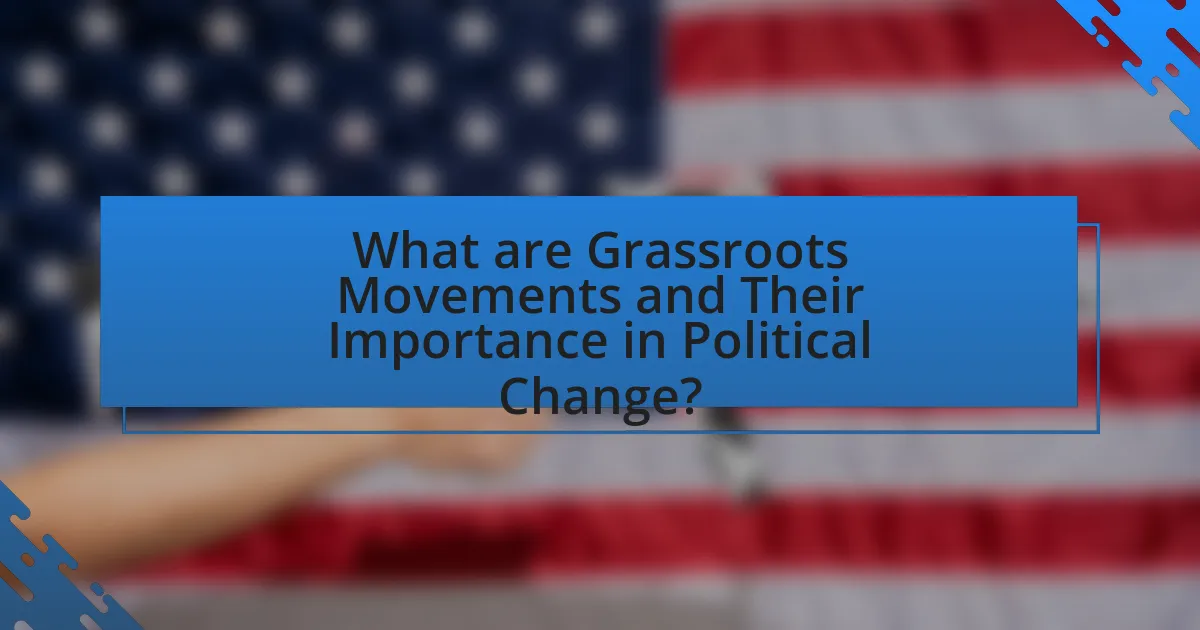
What are Grassroots Movements and Their Importance in Political Change?
Grassroots movements are organized efforts by ordinary people at the community level to effect social or political change. These movements are crucial in political change as they mobilize citizens, raise awareness about issues, and influence policymakers through collective action. Historical examples, such as the Civil Rights Movement in the United States, demonstrate how grassroots activism can lead to significant legislative changes, including the Civil Rights Act of 1964. Additionally, grassroots movements often serve as a counterbalance to established political structures, providing a voice for marginalized groups and fostering democratic engagement.
How do Grassroots Movements differ from Traditional Political Movements?
Grassroots movements differ from traditional political movements primarily in their structure and approach to mobilization. Grassroots movements are typically decentralized and driven by ordinary citizens at the community level, emphasizing local participation and direct action, while traditional political movements often rely on established political parties, hierarchies, and formal leadership structures. For example, the Civil Rights Movement in the United States utilized grassroots organizing to empower local communities, contrasting with traditional political movements that may focus on top-down strategies and institutional frameworks. This distinction highlights how grassroots movements prioritize collective action and community engagement over formal political processes.
What characteristics define Grassroots Movements?
Grassroots movements are characterized by their community-driven nature, where local individuals mobilize to advocate for social or political change. These movements typically emerge from the bottom up, relying on the collective efforts of ordinary people rather than established political institutions or leaders. They often focus on specific issues that directly affect the community, fostering a sense of ownership and empowerment among participants. Additionally, grassroots movements utilize informal networks and social media to organize, spread awareness, and galvanize support, which enhances their reach and impact. Historical examples, such as the Civil Rights Movement in the United States, illustrate how grassroots efforts can lead to significant political and social transformations.
Why are Grassroots Movements considered essential for political engagement?
Grassroots movements are considered essential for political engagement because they empower individuals at the community level to influence political processes and decisions. These movements mobilize ordinary citizens, fostering participation and raising awareness about social issues, which can lead to significant political change. For instance, the Civil Rights Movement in the United States demonstrated how grassroots organizing can challenge systemic injustices and effect legislative reforms, such as the Civil Rights Act of 1964. By creating a collective voice, grassroots movements can hold political leaders accountable and drive policy changes that reflect the needs and desires of the community.
What historical examples illustrate the impact of Grassroots Movements?
Grassroots movements have significantly influenced political change throughout history, with notable examples including the Civil Rights Movement in the United States and the anti-apartheid movement in South Africa. The Civil Rights Movement, which gained momentum in the 1950s and 1960s, mobilized ordinary citizens to demand equal rights and led to landmark legislation such as the Civil Rights Act of 1964 and the Voting Rights Act of 1965. This movement showcased the power of grassroots organizing, as local activists, including figures like Rosa Parks and Martin Luther King Jr., galvanized support and brought national attention to racial injustices.
Similarly, the anti-apartheid movement in South Africa, which spanned several decades, was driven by grassroots activism that united various groups against racial segregation and oppression. Key events, such as the Soweto Uprising in 1976, highlighted the determination of young activists and led to increased international pressure on the South African government. The movement ultimately contributed to the dismantling of apartheid and the election of Nelson Mandela as the first Black president in 1994. These examples illustrate how grassroots movements can mobilize communities, influence policy, and effect substantial political change.
How did the Civil Rights Movement exemplify Grassroots activism?
The Civil Rights Movement exemplified grassroots activism by mobilizing ordinary citizens to challenge systemic racial injustices through local organizing and direct action. This movement saw individuals and community groups, such as the Student Nonviolent Coordinating Committee (SNCC) and the Southern Christian Leadership Conference (SCLC), engage in protests, voter registration drives, and sit-ins, demonstrating the power of collective action. Notably, the Montgomery Bus Boycott in 1955, initiated by Rosa Parks, showcased how grassroots efforts could effectively disrupt discriminatory practices and garner national attention, leading to significant legal changes like the Civil Rights Act of 1964.
What role did Grassroots Movements play in the Arab Spring?
Grassroots movements were pivotal in the Arab Spring, serving as the primary catalysts for widespread protests and demands for political reform across the region. These movements mobilized citizens through social media and community organizing, effectively bypassing traditional political structures. For instance, in Tunisia, the grassroots movement known as the “Facebook Revolution” played a crucial role in the ousting of President Zine El Abidine Ben Ali in January 2011, demonstrating the power of collective action. Similarly, in Egypt, grassroots organizations like the April 6 Youth Movement galvanized thousands to protest against President Hosni Mubarak, leading to his resignation in February 2011. The success of these movements highlighted the significance of grassroots activism in challenging authoritarian regimes and advocating for democratic change in the Arab world.
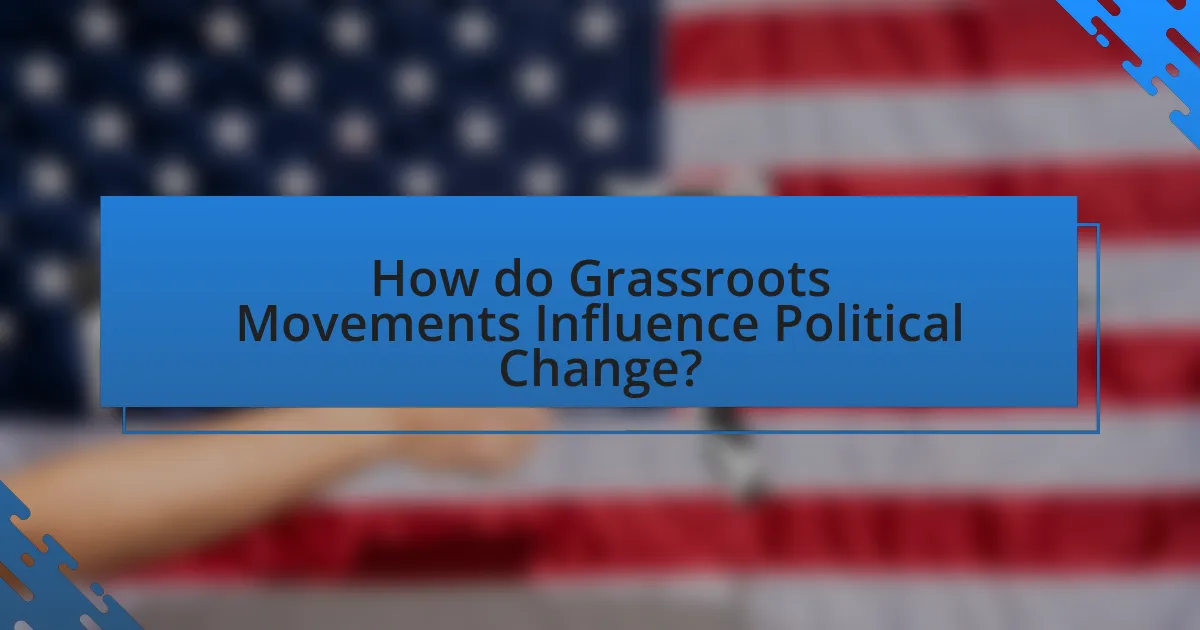
How do Grassroots Movements Influence Political Change?
Grassroots movements influence political change by mobilizing community members to advocate for specific issues, thereby creating pressure on policymakers. These movements often utilize strategies such as organizing protests, engaging in social media campaigns, and building coalitions to amplify their voices. For instance, the Civil Rights Movement in the United States effectively utilized grassroots organizing to challenge segregation laws, leading to significant legislative changes like the Civil Rights Act of 1964. Additionally, research indicates that grassroots movements can shift public opinion, as seen in the environmental movement, which has raised awareness about climate change and influenced policy decisions globally.
What strategies do Grassroots Movements employ to effect change?
Grassroots movements employ strategies such as community organizing, advocacy, and coalition-building to effect change. Community organizing involves mobilizing individuals at the local level to address specific issues, fostering a sense of collective identity and empowerment. Advocacy efforts focus on influencing policymakers and public opinion through campaigns, lobbying, and public demonstrations. Coalition-building brings together diverse groups to amplify their voices and resources, enhancing their impact on social and political issues. Historical examples include the Civil Rights Movement, where grassroots strategies led to significant legislative changes, such as the Civil Rights Act of 1964, demonstrating the effectiveness of these approaches in achieving political change.
How do social media and technology enhance Grassroots organizing?
Social media and technology enhance grassroots organizing by facilitating rapid communication, mobilization, and community engagement. These platforms allow grassroots movements to disseminate information quickly, reaching a wider audience and enabling real-time updates on events and campaigns. For instance, during the Arab Spring, social media played a crucial role in organizing protests and sharing information, demonstrating its effectiveness in mobilizing collective action. Additionally, technology provides tools for fundraising and resource sharing, which are essential for sustaining grassroots initiatives. According to a study by the Pew Research Center, 69% of adults in the U.S. use social media, highlighting its potential to connect individuals and foster community support for grassroots efforts.
What role does community engagement play in the success of Grassroots Movements?
Community engagement is crucial for the success of grassroots movements as it fosters collective action and mobilizes individuals towards a common goal. When community members actively participate, they contribute diverse perspectives and resources, enhancing the movement’s legitimacy and reach. For instance, the Civil Rights Movement in the United States gained momentum through local organizing and community involvement, leading to significant legislative changes such as the Civil Rights Act of 1964. This demonstrates that effective community engagement not only amplifies voices but also drives tangible political outcomes, validating its essential role in grassroots movements.
Why are Grassroots Movements effective in mobilizing public support?
Grassroots movements are effective in mobilizing public support because they engage individuals at the community level, fostering a sense of ownership and personal investment in the cause. This localized approach allows movements to resonate with people’s everyday experiences and concerns, making the issues more relatable and urgent. For example, the Civil Rights Movement in the United States successfully mobilized public support through community organizing and local activism, leading to significant legislative changes such as the Civil Rights Act of 1964. Additionally, grassroots movements often utilize social media to amplify their message, reaching wider audiences quickly and effectively, as seen in the Arab Spring, where local activists mobilized mass protests through digital platforms.
How do personal stories and narratives drive Grassroots campaigns?
Personal stories and narratives drive grassroots campaigns by creating emotional connections that resonate with individuals and mobilize communities. These narratives humanize issues, making them relatable and compelling, which can inspire action and foster solidarity among supporters. For instance, campaigns like the “Me Too” movement utilized personal testimonies to highlight the prevalence of sexual harassment, effectively galvanizing public support and prompting legislative changes. Research indicates that storytelling can increase engagement and empathy, leading to higher participation rates in grassroots initiatives.
What psychological factors contribute to the effectiveness of Grassroots Movements?
Psychological factors that contribute to the effectiveness of grassroots movements include collective identity, social cohesion, and perceived efficacy. Collective identity fosters a sense of belonging among participants, which enhances commitment and motivation to the cause. Social cohesion strengthens relationships within the group, facilitating collaboration and resource sharing. Perceived efficacy, the belief that collective action can lead to meaningful change, drives individuals to engage actively in the movement. Research indicates that these psychological elements are crucial for mobilizing support and sustaining momentum, as seen in successful movements like the Civil Rights Movement, where strong collective identity and social ties were pivotal in achieving legislative change.
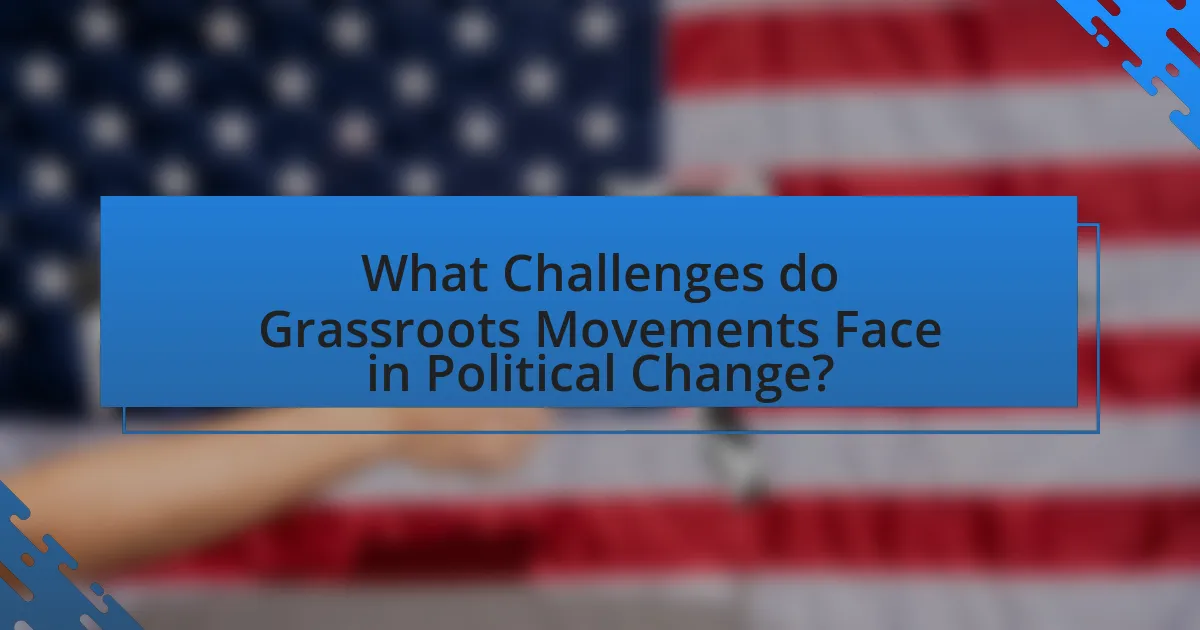
What Challenges do Grassroots Movements Face in Political Change?
Grassroots movements face significant challenges in achieving political change, primarily due to limited resources, institutional resistance, and fragmentation within their ranks. Limited financial and human resources hinder their ability to mobilize effectively and sustain campaigns, as evidenced by studies showing that well-funded organizations often dominate political discourse. Institutional resistance manifests through legal barriers, political pushback, and co-optation by established political entities, which can dilute the original goals of grassroots initiatives. Additionally, fragmentation occurs when differing ideologies and strategies among grassroots groups lead to disunity, making it difficult to present a cohesive front. These challenges collectively impede the effectiveness of grassroots movements in driving substantial political change.
What obstacles hinder the progress of Grassroots Movements?
Grassroots movements face several obstacles that hinder their progress, including lack of funding, political repression, and internal divisions. Lack of funding restricts their ability to mobilize resources, conduct outreach, and sustain activities, as evidenced by studies showing that financial constraints are a primary reason for the failure of many grassroots initiatives. Political repression, such as government crackdowns on protests or the targeting of activists, can stifle movement activities and discourage participation, as seen in various countries where authoritarian regimes suppress dissent. Internal divisions, often stemming from differing ideologies or strategies among members, can lead to fragmentation and weaken collective action, which has been documented in movements like Occupy Wall Street. These factors collectively impede the effectiveness and sustainability of grassroots movements in driving political change.
How do funding and resource limitations affect Grassroots initiatives?
Funding and resource limitations significantly hinder grassroots initiatives by restricting their operational capacity and outreach. Limited financial resources often result in reduced staffing, inadequate training, and insufficient materials, which directly impact the effectiveness of campaigns and community engagement efforts. For instance, a study by the National Committee for Responsive Philanthropy found that grassroots organizations with less than $100,000 in annual funding struggle to mobilize community support and achieve policy changes compared to those with larger budgets. Consequently, these limitations can stifle innovation and diminish the overall impact of grassroots movements in driving political change.
What role does political opposition play in challenging Grassroots Movements?
Political opposition plays a significant role in challenging grassroots movements by mobilizing resources, framing narratives, and leveraging institutional power to undermine their objectives. For instance, political parties may discredit grassroots initiatives by portraying them as radical or unrepresentative of mainstream values, which can diminish public support. Additionally, opposition groups may engage in counter-mobilization, organizing their own supporters to counteract grassroots demonstrations, as seen in various political contexts where established parties have sought to maintain their influence against emerging movements. This dynamic can lead to legislative pushback, where political opposition seeks to enact laws that restrict the activities of grassroots organizations, thereby limiting their effectiveness and reach.
How can Grassroots Movements overcome these challenges?
Grassroots movements can overcome challenges by building strong community networks and leveraging social media for mobilization. These networks foster collaboration and resource sharing, which enhances resilience against opposition. For instance, the Women’s March in 2017 utilized social media to organize millions of participants globally, demonstrating effective mobilization. Additionally, grassroots movements can engage in strategic partnerships with established organizations to gain credibility and access resources, as seen with the Black Lives Matter movement collaborating with civil rights organizations to amplify their message. By focusing on local issues and creating inclusive spaces for dialogue, grassroots movements can effectively address community-specific challenges and drive political change.
What strategies can be employed to secure funding and resources?
Grassroots movements can secure funding and resources through diverse strategies such as building strong community networks, leveraging social media for crowdfunding, and establishing partnerships with local businesses and organizations. Community networks foster trust and engagement, which can lead to increased donations and volunteer support. For instance, the 2016 Bernie Sanders campaign utilized grassroots fundraising effectively, raising over $230 million from small donations, demonstrating the power of community engagement. Social media platforms enable movements to reach a wider audience, facilitating crowdfunding campaigns that can generate significant financial support. Additionally, partnerships with local businesses can provide both financial resources and in-kind support, enhancing the movement’s visibility and credibility. These strategies collectively enhance the capacity of grassroots movements to mobilize resources effectively.
How can Grassroots Movements build coalitions to strengthen their impact?
Grassroots movements can build coalitions to strengthen their impact by identifying shared goals and values with other organizations and communities. By collaborating with like-minded groups, grassroots movements can pool resources, share knowledge, and amplify their collective voice, which enhances their ability to influence policy and public opinion. For instance, the Women’s March in 2017 successfully united various organizations advocating for women’s rights, racial equality, and rights, demonstrating how diverse groups can come together for a common cause. This coalition-building approach not only increases visibility but also fosters solidarity, making it easier to mobilize larger numbers of supporters for campaigns and initiatives.
What best practices can enhance the effectiveness of Grassroots Movements?
Effective grassroots movements can be enhanced by building strong community networks, utilizing social media for outreach, and fostering inclusive participation. Strong community networks create a foundation for mobilization, as evidenced by the success of the Civil Rights Movement, which relied on local organizations to coordinate efforts and amplify voices. Social media serves as a powerful tool for outreach, allowing movements to reach wider audiences quickly; for instance, the #MeToo movement gained global traction through platforms like Twitter and Facebook. Additionally, fostering inclusive participation ensures diverse perspectives are represented, which can strengthen the movement’s legitimacy and appeal, as seen in the Women’s March, where various groups united for a common cause.
How can Grassroots Movements effectively utilize social media for outreach?
Grassroots movements can effectively utilize social media for outreach by creating engaging content that resonates with their target audience and encourages participation. By leveraging platforms like Facebook, Twitter, and Instagram, these movements can share compelling narratives, mobilize supporters, and disseminate information rapidly. For instance, the Black Lives Matter movement utilized social media to amplify its message, resulting in widespread awareness and participation in protests, as evidenced by the millions of posts and shares during the 2020 protests. Additionally, social media analytics can help grassroots organizations track engagement and adapt their strategies in real-time, ensuring their outreach efforts are both effective and responsive to community needs.
What are the key elements of successful Grassroots campaign planning?
Successful grassroots campaign planning involves clear objectives, community engagement, strategic messaging, and effective resource allocation. Clear objectives define the campaign’s goals, ensuring all efforts are aligned towards a common purpose. Community engagement fosters local support and mobilizes volunteers, which is crucial for grassroots movements; for instance, the 2018 midterm elections saw significant voter turnout driven by community-led initiatives. Strategic messaging communicates the campaign’s values and resonates with the target audience, enhancing outreach effectiveness. Lastly, effective resource allocation ensures that time, money, and human resources are utilized efficiently, as demonstrated by successful campaigns that prioritize grassroots fundraising and volunteer training.
